Warehouse Safety: Assessing and Facilitating for BS204
VerifiedAdded on 2023/04/25
|26
|8201
|51
Report
AI Summary
This report, submitted as coursework for BS204 Warehousing Management, focuses on assessing and facilitating warehouse safety. It begins with an abstract highlighting the importance of safety in warehouse environments and the associated risks. The introduction emphasizes the need for safety due to the dynamic and potentially dangerous nature of warehouse operations, citing statistics on workplace accidents and injuries. The purpose of the report is to evaluate and facilitate warehouse safety, focusing on safety behaviors, safety leadership, and facility improvements. The literature review explores safety culture, its dimensions, and safety behavior, referencing relevant studies and definitions. The methodology includes case study research, research instruments, and data analysis. The report identifies findings related to sub-dimensions of safety culture and behavior, discusses research limitations, and presents practical implications. It also addresses originality, draws conclusions, and provides recommendations for future research. The report underscores the importance of safety culture, behavior, and proactive measures to reduce accidents and improve overall safety performance in warehouses, supported by examples of warehouse incidents and their causes.
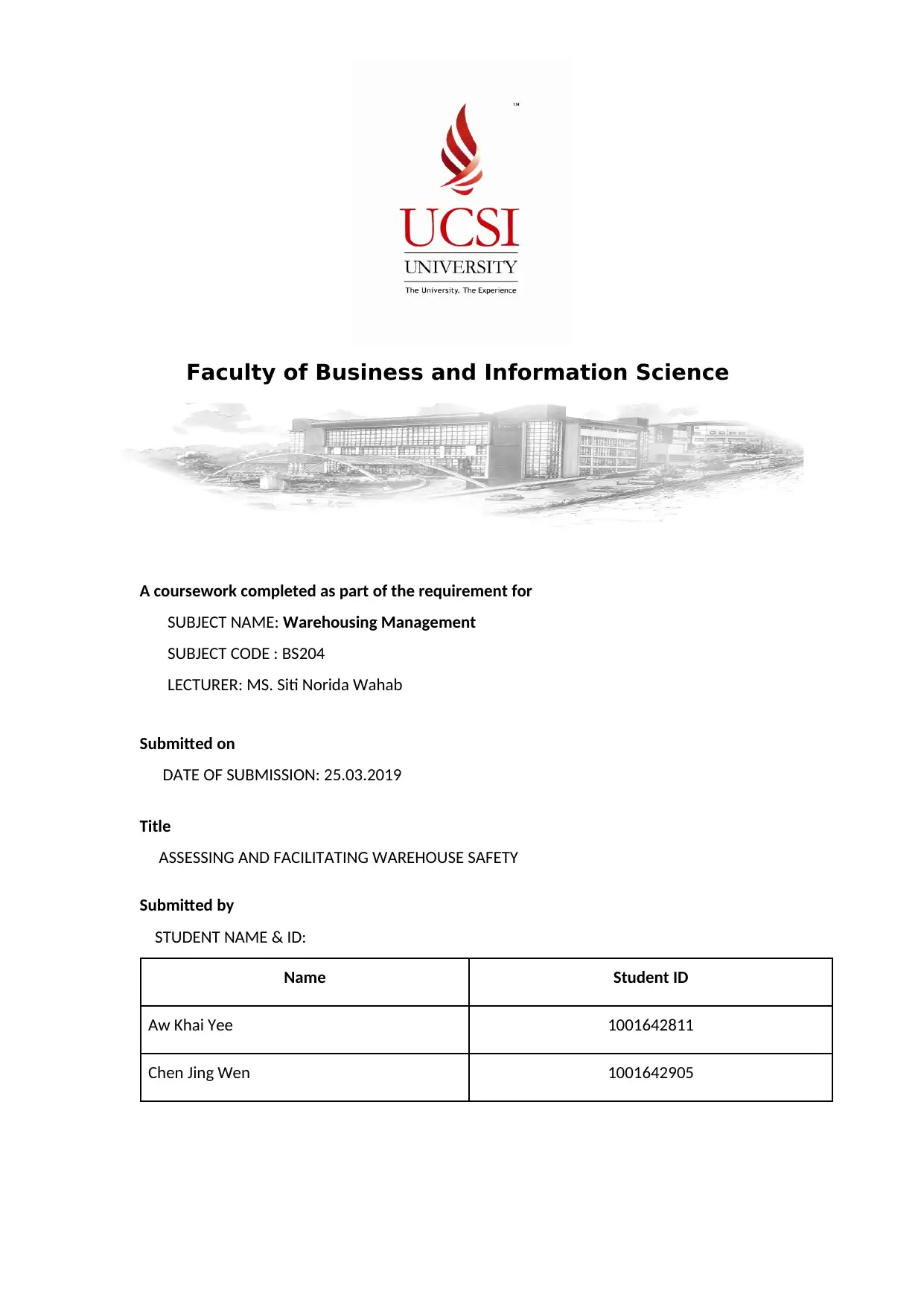
A coursework completed as part of the requirement for
SUBJECT NAME: Warehousing Management
SUBJECT CODE : BS204
LECTURER: MS. Siti Norida Wahab
Submitted on
DATE OF SUBMISSION: 25.03.2019
Title
ASSESSING AND FACILITATING WAREHOUSE SAFETY
Submitted by
STUDENT NAME & ID:
Name Student ID
Aw Khai Yee 1001642811
Chen Jing Wen 1001642905
Faculty of Business and Information Science
SUBJECT NAME: Warehousing Management
SUBJECT CODE : BS204
LECTURER: MS. Siti Norida Wahab
Submitted on
DATE OF SUBMISSION: 25.03.2019
Title
ASSESSING AND FACILITATING WAREHOUSE SAFETY
Submitted by
STUDENT NAME & ID:
Name Student ID
Aw Khai Yee 1001642811
Chen Jing Wen 1001642905
Faculty of Business and Information Science
Paraphrase This Document
Need a fresh take? Get an instant paraphrase of this document with our AI Paraphraser
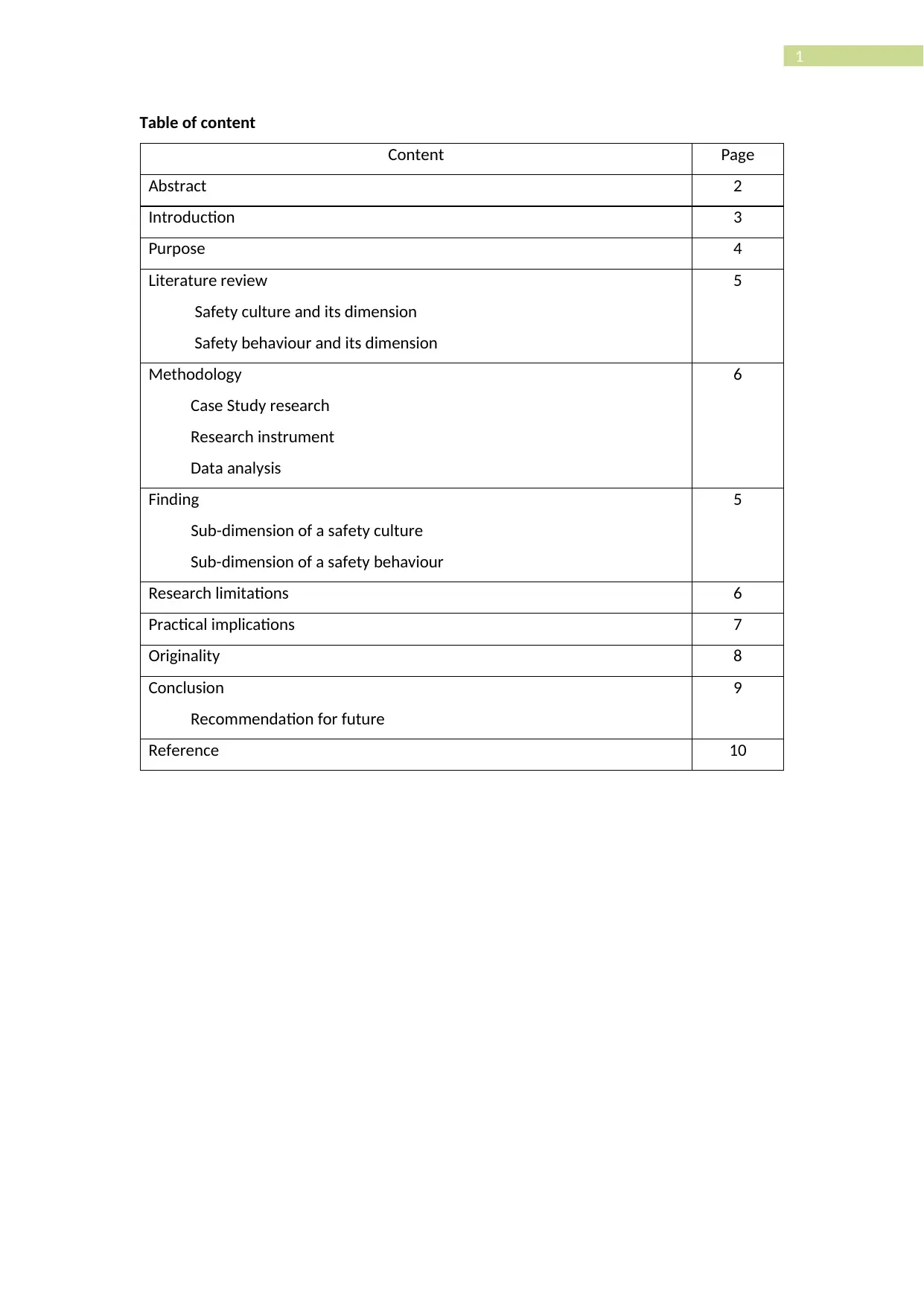
1
Table of content
Content Page
Abstract 2
Introduction 3
Purpose 4
Literature review
Safety culture and its dimension
Safety behaviour and its dimension
5
Methodology
Case Study research
Research instrument
Data analysis
6
Finding
Sub-dimension of a safety culture
Sub-dimension of a safety behaviour
5
Research limitations 6
Practical implications 7
Originality 8
Conclusion
Recommendation for future
9
Reference 10
Table of content
Content Page
Abstract 2
Introduction 3
Purpose 4
Literature review
Safety culture and its dimension
Safety behaviour and its dimension
5
Methodology
Case Study research
Research instrument
Data analysis
6
Finding
Sub-dimension of a safety culture
Sub-dimension of a safety behaviour
5
Research limitations 6
Practical implications 7
Originality 8
Conclusion
Recommendation for future
9
Reference 10
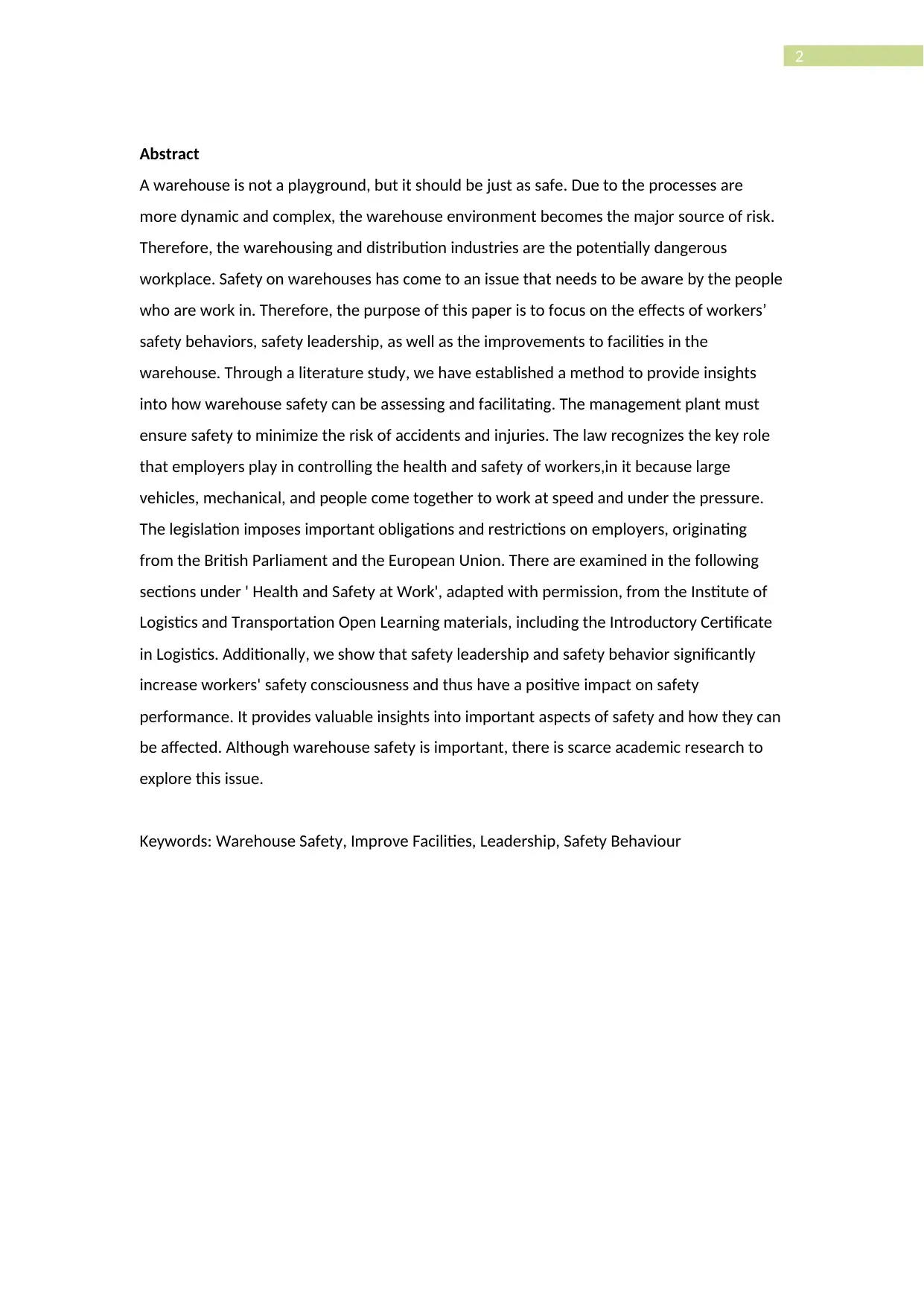
2
Abstract
A warehouse is not a playground, but it should be just as safe. Due to the processes are
more dynamic and complex, the warehouse environment becomes the major source of risk.
Therefore, the warehousing and distribution industries are the potentially dangerous
workplace. Safety on warehouses has come to an issue that needs to be aware by the people
who are work in. Therefore, the purpose of this paper is to focus on the effects of workers’
safety behaviors, safety leadership, as well as the improvements to facilities in the
warehouse. Through a literature study, we have established a method to provide insights
into how warehouse safety can be assessing and facilitating. The management plant must
ensure safety to minimize the risk of accidents and injuries. The law recognizes the key role
that employers play in controlling the health and safety of workers,in it because large
vehicles, mechanical, and people come together to work at speed and under the pressure.
The legislation imposes important obligations and restrictions on employers, originating
from the British Parliament and the European Union. There are examined in the following
sections under ' Health and Safety at Work', adapted with permission, from the Institute of
Logistics and Transportation Open Learning materials, including the Introductory Certificate
in Logistics. Additionally, we show that safety leadership and safety behavior significantly
increase workers' safety consciousness and thus have a positive impact on safety
performance. It provides valuable insights into important aspects of safety and how they can
be affected. Although warehouse safety is important, there is scarce academic research to
explore this issue.
Keywords: Warehouse Safety, Improve Facilities, Leadership, Safety Behaviour
Abstract
A warehouse is not a playground, but it should be just as safe. Due to the processes are
more dynamic and complex, the warehouse environment becomes the major source of risk.
Therefore, the warehousing and distribution industries are the potentially dangerous
workplace. Safety on warehouses has come to an issue that needs to be aware by the people
who are work in. Therefore, the purpose of this paper is to focus on the effects of workers’
safety behaviors, safety leadership, as well as the improvements to facilities in the
warehouse. Through a literature study, we have established a method to provide insights
into how warehouse safety can be assessing and facilitating. The management plant must
ensure safety to minimize the risk of accidents and injuries. The law recognizes the key role
that employers play in controlling the health and safety of workers,in it because large
vehicles, mechanical, and people come together to work at speed and under the pressure.
The legislation imposes important obligations and restrictions on employers, originating
from the British Parliament and the European Union. There are examined in the following
sections under ' Health and Safety at Work', adapted with permission, from the Institute of
Logistics and Transportation Open Learning materials, including the Introductory Certificate
in Logistics. Additionally, we show that safety leadership and safety behavior significantly
increase workers' safety consciousness and thus have a positive impact on safety
performance. It provides valuable insights into important aspects of safety and how they can
be affected. Although warehouse safety is important, there is scarce academic research to
explore this issue.
Keywords: Warehouse Safety, Improve Facilities, Leadership, Safety Behaviour
⊘ This is a preview!⊘
Do you want full access?
Subscribe today to unlock all pages.

Trusted by 1+ million students worldwide
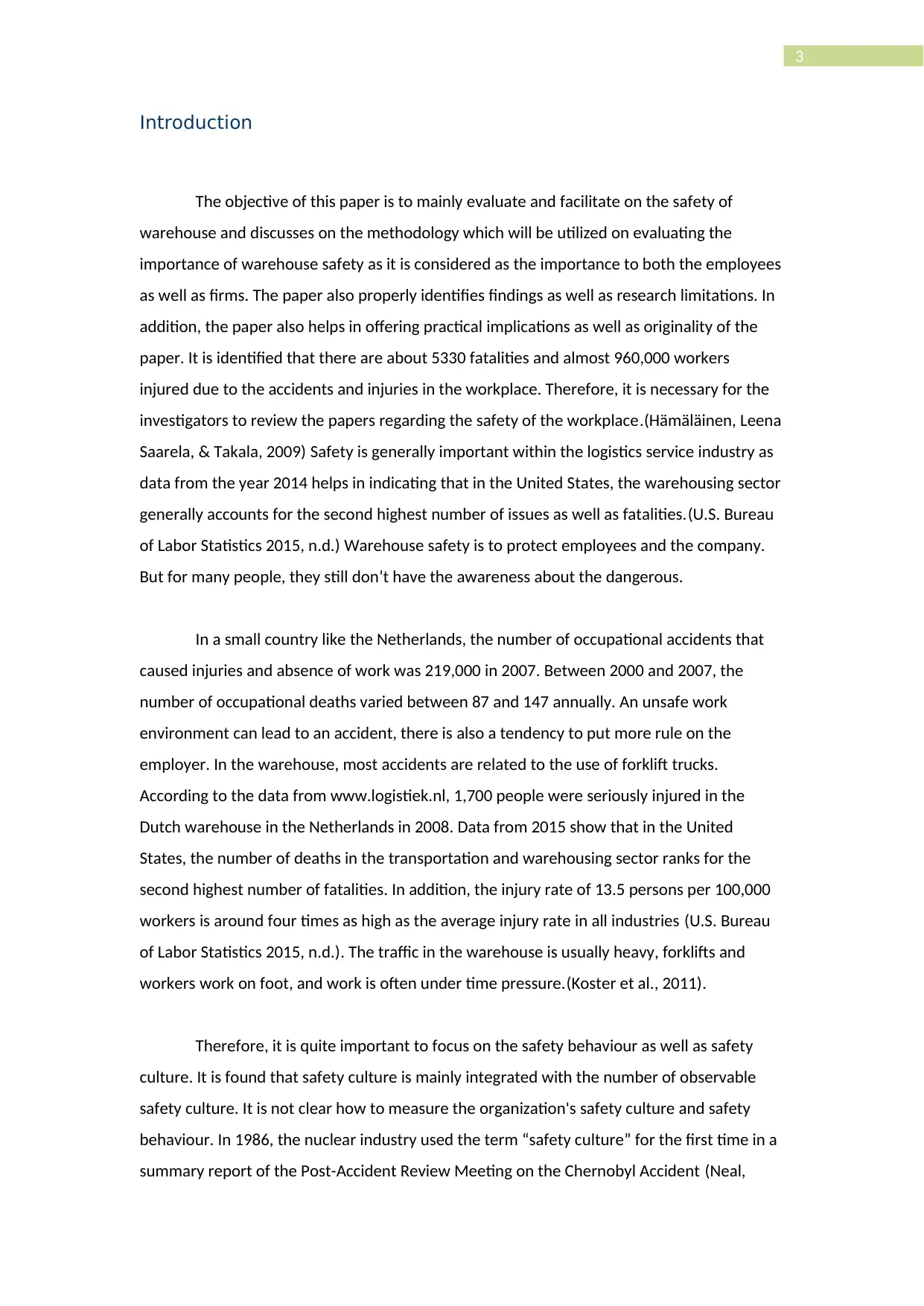
3
Introduction
The objective of this paper is to mainly evaluate and facilitate on the safety of
warehouse and discusses on the methodology which will be utilized on evaluating the
importance of warehouse safety as it is considered as the importance to both the employees
as well as firms. The paper also properly identifies findings as well as research limitations. In
addition, the paper also helps in offering practical implications as well as originality of the
paper. It is identified that there are about 5330 fatalities and almost 960,000 workers
injured due to the accidents and injuries in the workplace. Therefore, it is necessary for the
investigators to review the papers regarding the safety of the workplace.(Hämäläinen, Leena
Saarela, & Takala, 2009) Safety is generally important within the logistics service industry as
data from the year 2014 helps in indicating that in the United States, the warehousing sector
generally accounts for the second highest number of issues as well as fatalities.(U.S. Bureau
of Labor Statistics 2015, n.d.) Warehouse safety is to protect employees and the company.
But for many people, they still don’t have the awareness about the dangerous.
In a small country like the Netherlands, the number of occupational accidents that
caused injuries and absence of work was 219,000 in 2007. Between 2000 and 2007, the
number of occupational deaths varied between 87 and 147 annually. An unsafe work
environment can lead to an accident, there is also a tendency to put more rule on the
employer. In the warehouse, most accidents are related to the use of forklift trucks.
According to the data from www.logistiek.nl, 1,700 people were seriously injured in the
Dutch warehouse in the Netherlands in 2008. Data from 2015 show that in the United
States, the number of deaths in the transportation and warehousing sector ranks for the
second highest number of fatalities. In addition, the injury rate of 13.5 persons per 100,000
workers is around four times as high as the average injury rate in all industries (U.S. Bureau
of Labor Statistics 2015, n.d.). The traffic in the warehouse is usually heavy, forklifts and
workers work on foot, and work is often under time pressure.(Koster et al., 2011).
Therefore, it is quite important to focus on the safety behaviour as well as safety
culture. It is found that safety culture is mainly integrated with the number of observable
safety culture. It is not clear how to measure the organization's safety culture and safety
behaviour. In 1986, the nuclear industry used the term “safety culture” for the first time in a
summary report of the Post-Accident Review Meeting on the Chernobyl Accident (Neal,
Introduction
The objective of this paper is to mainly evaluate and facilitate on the safety of
warehouse and discusses on the methodology which will be utilized on evaluating the
importance of warehouse safety as it is considered as the importance to both the employees
as well as firms. The paper also properly identifies findings as well as research limitations. In
addition, the paper also helps in offering practical implications as well as originality of the
paper. It is identified that there are about 5330 fatalities and almost 960,000 workers
injured due to the accidents and injuries in the workplace. Therefore, it is necessary for the
investigators to review the papers regarding the safety of the workplace.(Hämäläinen, Leena
Saarela, & Takala, 2009) Safety is generally important within the logistics service industry as
data from the year 2014 helps in indicating that in the United States, the warehousing sector
generally accounts for the second highest number of issues as well as fatalities.(U.S. Bureau
of Labor Statistics 2015, n.d.) Warehouse safety is to protect employees and the company.
But for many people, they still don’t have the awareness about the dangerous.
In a small country like the Netherlands, the number of occupational accidents that
caused injuries and absence of work was 219,000 in 2007. Between 2000 and 2007, the
number of occupational deaths varied between 87 and 147 annually. An unsafe work
environment can lead to an accident, there is also a tendency to put more rule on the
employer. In the warehouse, most accidents are related to the use of forklift trucks.
According to the data from www.logistiek.nl, 1,700 people were seriously injured in the
Dutch warehouse in the Netherlands in 2008. Data from 2015 show that in the United
States, the number of deaths in the transportation and warehousing sector ranks for the
second highest number of fatalities. In addition, the injury rate of 13.5 persons per 100,000
workers is around four times as high as the average injury rate in all industries (U.S. Bureau
of Labor Statistics 2015, n.d.). The traffic in the warehouse is usually heavy, forklifts and
workers work on foot, and work is often under time pressure.(Koster et al., 2011).
Therefore, it is quite important to focus on the safety behaviour as well as safety
culture. It is found that safety culture is mainly integrated with the number of observable
safety culture. It is not clear how to measure the organization's safety culture and safety
behaviour. In 1986, the nuclear industry used the term “safety culture” for the first time in a
summary report of the Post-Accident Review Meeting on the Chernobyl Accident (Neal,
Paraphrase This Document
Need a fresh take? Get an instant paraphrase of this document with our AI Paraphraser
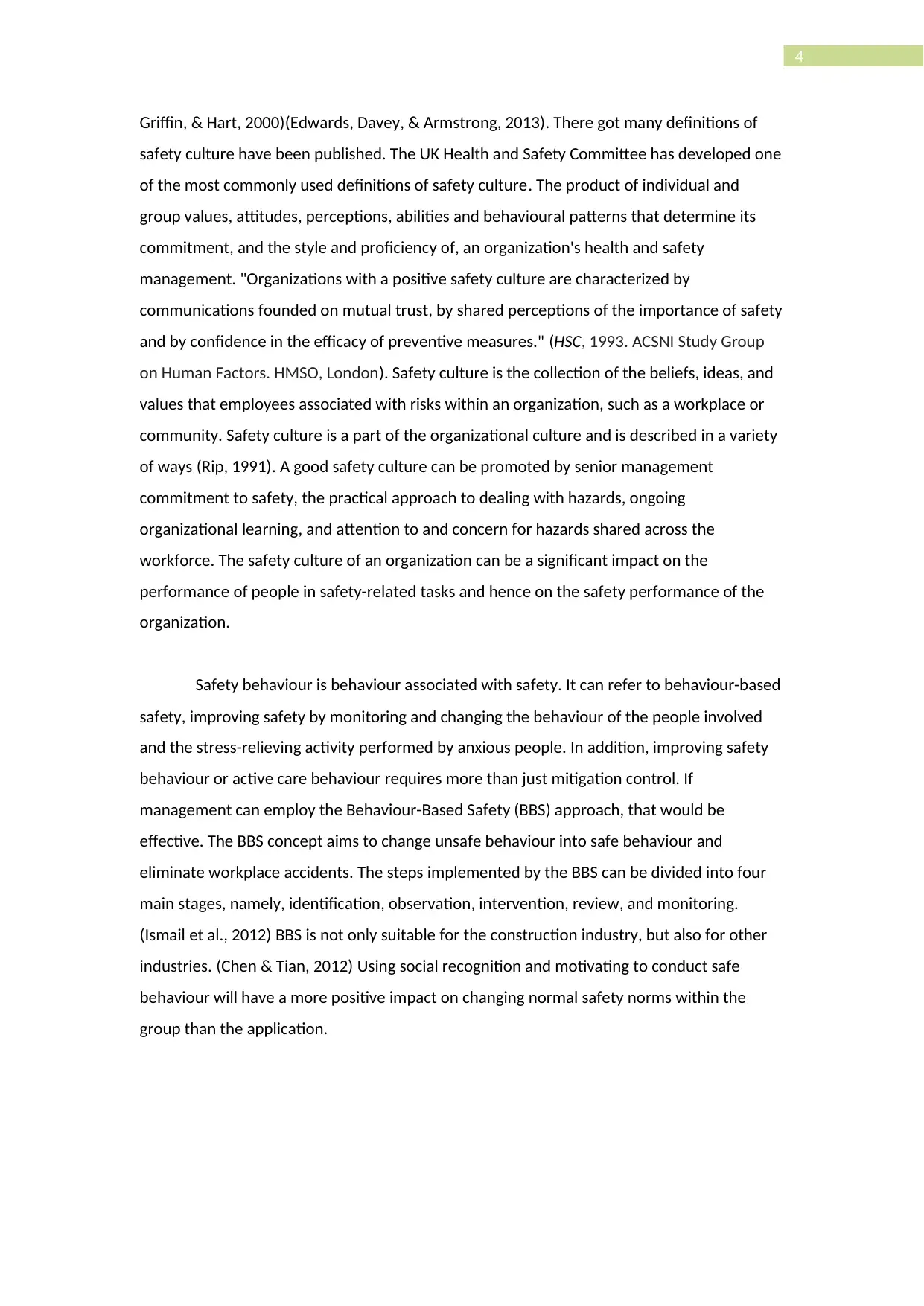
4
Griffin, & Hart, 2000)(Edwards, Davey, & Armstrong, 2013). There got many definitions of
safety culture have been published. The UK Health and Safety Committee has developed one
of the most commonly used definitions of safety culture. The product of individual and
group values, attitudes, perceptions, abilities and behavioural patterns that determine its
commitment, and the style and proficiency of, an organization's health and safety
management. "Organizations with a positive safety culture are characterized by
communications founded on mutual trust, by shared perceptions of the importance of safety
and by confidence in the efficacy of preventive measures." (HSC, 1993. ACSNI Study Group
on Human Factors. HMSO, London). Safety culture is the collection of the beliefs, ideas, and
values that employees associated with risks within an organization, such as a workplace or
community. Safety culture is a part of the organizational culture and is described in a variety
of ways (Rip, 1991). A good safety culture can be promoted by senior management
commitment to safety, the practical approach to dealing with hazards, ongoing
organizational learning, and attention to and concern for hazards shared across the
workforce. The safety culture of an organization can be a significant impact on the
performance of people in safety-related tasks and hence on the safety performance of the
organization.
Safety behaviour is behaviour associated with safety. It can refer to behaviour-based
safety, improving safety by monitoring and changing the behaviour of the people involved
and the stress-relieving activity performed by anxious people. In addition, improving safety
behaviour or active care behaviour requires more than just mitigation control. If
management can employ the Behaviour-Based Safety (BBS) approach, that would be
effective. The BBS concept aims to change unsafe behaviour into safe behaviour and
eliminate workplace accidents. The steps implemented by the BBS can be divided into four
main stages, namely, identification, observation, intervention, review, and monitoring.
(Ismail et al., 2012) BBS is not only suitable for the construction industry, but also for other
industries. (Chen & Tian, 2012) Using social recognition and motivating to conduct safe
behaviour will have a more positive impact on changing normal safety norms within the
group than the application.
Griffin, & Hart, 2000)(Edwards, Davey, & Armstrong, 2013). There got many definitions of
safety culture have been published. The UK Health and Safety Committee has developed one
of the most commonly used definitions of safety culture. The product of individual and
group values, attitudes, perceptions, abilities and behavioural patterns that determine its
commitment, and the style and proficiency of, an organization's health and safety
management. "Organizations with a positive safety culture are characterized by
communications founded on mutual trust, by shared perceptions of the importance of safety
and by confidence in the efficacy of preventive measures." (HSC, 1993. ACSNI Study Group
on Human Factors. HMSO, London). Safety culture is the collection of the beliefs, ideas, and
values that employees associated with risks within an organization, such as a workplace or
community. Safety culture is a part of the organizational culture and is described in a variety
of ways (Rip, 1991). A good safety culture can be promoted by senior management
commitment to safety, the practical approach to dealing with hazards, ongoing
organizational learning, and attention to and concern for hazards shared across the
workforce. The safety culture of an organization can be a significant impact on the
performance of people in safety-related tasks and hence on the safety performance of the
organization.
Safety behaviour is behaviour associated with safety. It can refer to behaviour-based
safety, improving safety by monitoring and changing the behaviour of the people involved
and the stress-relieving activity performed by anxious people. In addition, improving safety
behaviour or active care behaviour requires more than just mitigation control. If
management can employ the Behaviour-Based Safety (BBS) approach, that would be
effective. The BBS concept aims to change unsafe behaviour into safe behaviour and
eliminate workplace accidents. The steps implemented by the BBS can be divided into four
main stages, namely, identification, observation, intervention, review, and monitoring.
(Ismail et al., 2012) BBS is not only suitable for the construction industry, but also for other
industries. (Chen & Tian, 2012) Using social recognition and motivating to conduct safe
behaviour will have a more positive impact on changing normal safety norms within the
group than the application.
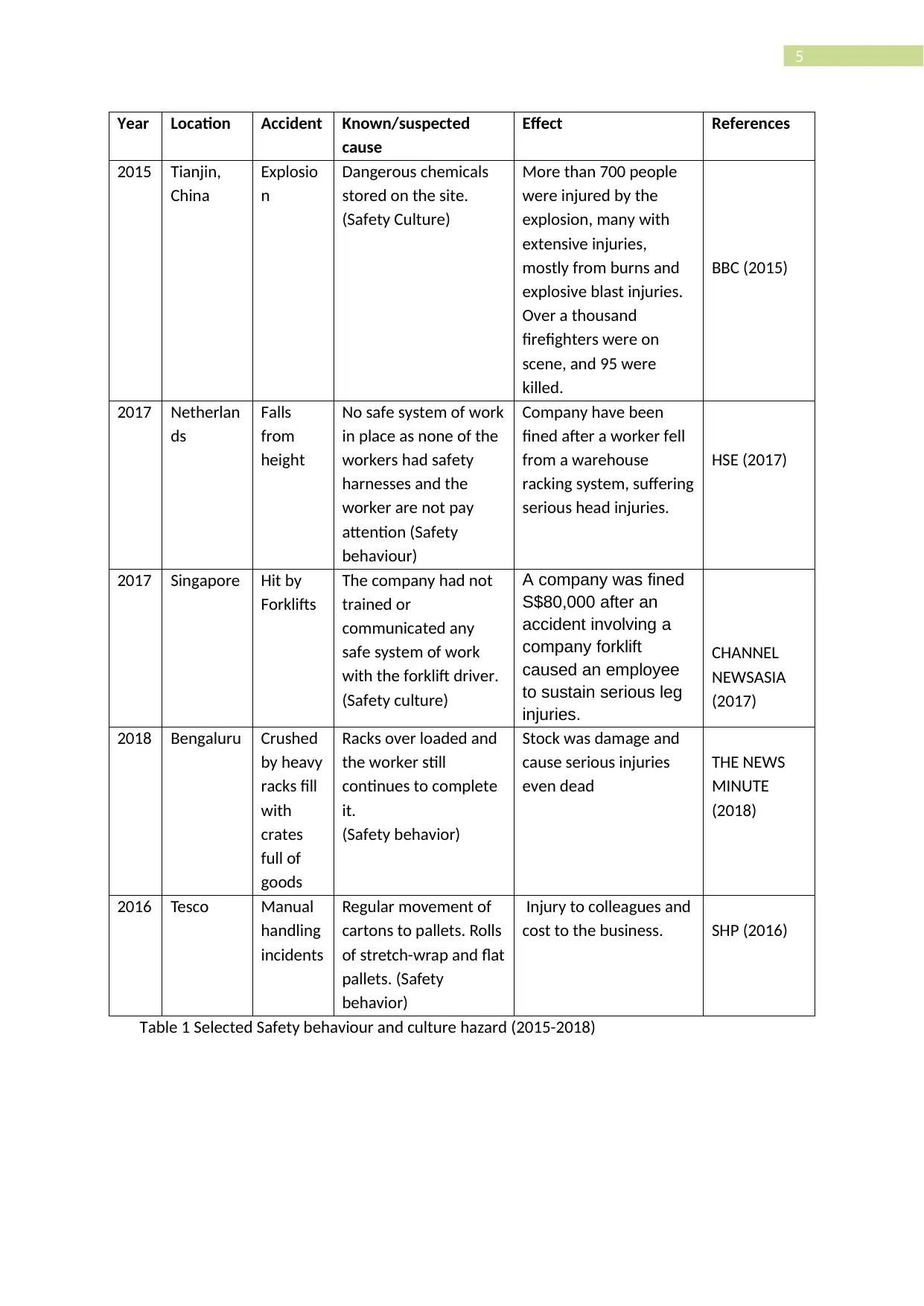
5
Year Location Accident Known/suspected
cause
Effect References
2015 Tianjin,
China
Explosio
n
Dangerous chemicals
stored on the site.
(Safety Culture)
More than 700 people
were injured by the
explosion, many with
extensive injuries,
mostly from burns and
explosive blast injuries.
Over a thousand
firefighters were on
scene, and 95 were
killed.
BBC (2015)
2017 Netherlan
ds
Falls
from
height
No safe system of work
in place as none of the
workers had safety
harnesses and the
worker are not pay
attention (Safety
behaviour)
Company have been
fined after a worker fell
from a warehouse
racking system, suffering
serious head injuries.
HSE (2017)
2017 Singapore Hit by
Forklifts
The company had not
trained or
communicated any
safe system of work
with the forklift driver.
(Safety culture)
A company was fined
S$80,000 after an
accident involving a
company forklift
caused an employee
to sustain serious leg
injuries.
CHANNEL
NEWSASIA
(2017)
2018 Bengaluru Crushed
by heavy
racks fill
with
crates
full of
goods
Racks over loaded and
the worker still
continues to complete
it.
(Safety behavior)
Stock was damage and
cause serious injuries
even dead
THE NEWS
MINUTE
(2018)
2016 Tesco Manual
handling
incidents
Regular movement of
cartons to pallets. Rolls
of stretch-wrap and flat
pallets. (Safety
behavior)
Injury to colleagues and
cost to the business. SHP (2016)
Table 1 Selected Safety behaviour and culture hazard (2015-2018)
Year Location Accident Known/suspected
cause
Effect References
2015 Tianjin,
China
Explosio
n
Dangerous chemicals
stored on the site.
(Safety Culture)
More than 700 people
were injured by the
explosion, many with
extensive injuries,
mostly from burns and
explosive blast injuries.
Over a thousand
firefighters were on
scene, and 95 were
killed.
BBC (2015)
2017 Netherlan
ds
Falls
from
height
No safe system of work
in place as none of the
workers had safety
harnesses and the
worker are not pay
attention (Safety
behaviour)
Company have been
fined after a worker fell
from a warehouse
racking system, suffering
serious head injuries.
HSE (2017)
2017 Singapore Hit by
Forklifts
The company had not
trained or
communicated any
safe system of work
with the forklift driver.
(Safety culture)
A company was fined
S$80,000 after an
accident involving a
company forklift
caused an employee
to sustain serious leg
injuries.
CHANNEL
NEWSASIA
(2017)
2018 Bengaluru Crushed
by heavy
racks fill
with
crates
full of
goods
Racks over loaded and
the worker still
continues to complete
it.
(Safety behavior)
Stock was damage and
cause serious injuries
even dead
THE NEWS
MINUTE
(2018)
2016 Tesco Manual
handling
incidents
Regular movement of
cartons to pallets. Rolls
of stretch-wrap and flat
pallets. (Safety
behavior)
Injury to colleagues and
cost to the business. SHP (2016)
Table 1 Selected Safety behaviour and culture hazard (2015-2018)
⊘ This is a preview!⊘
Do you want full access?
Subscribe today to unlock all pages.

Trusted by 1+ million students worldwide
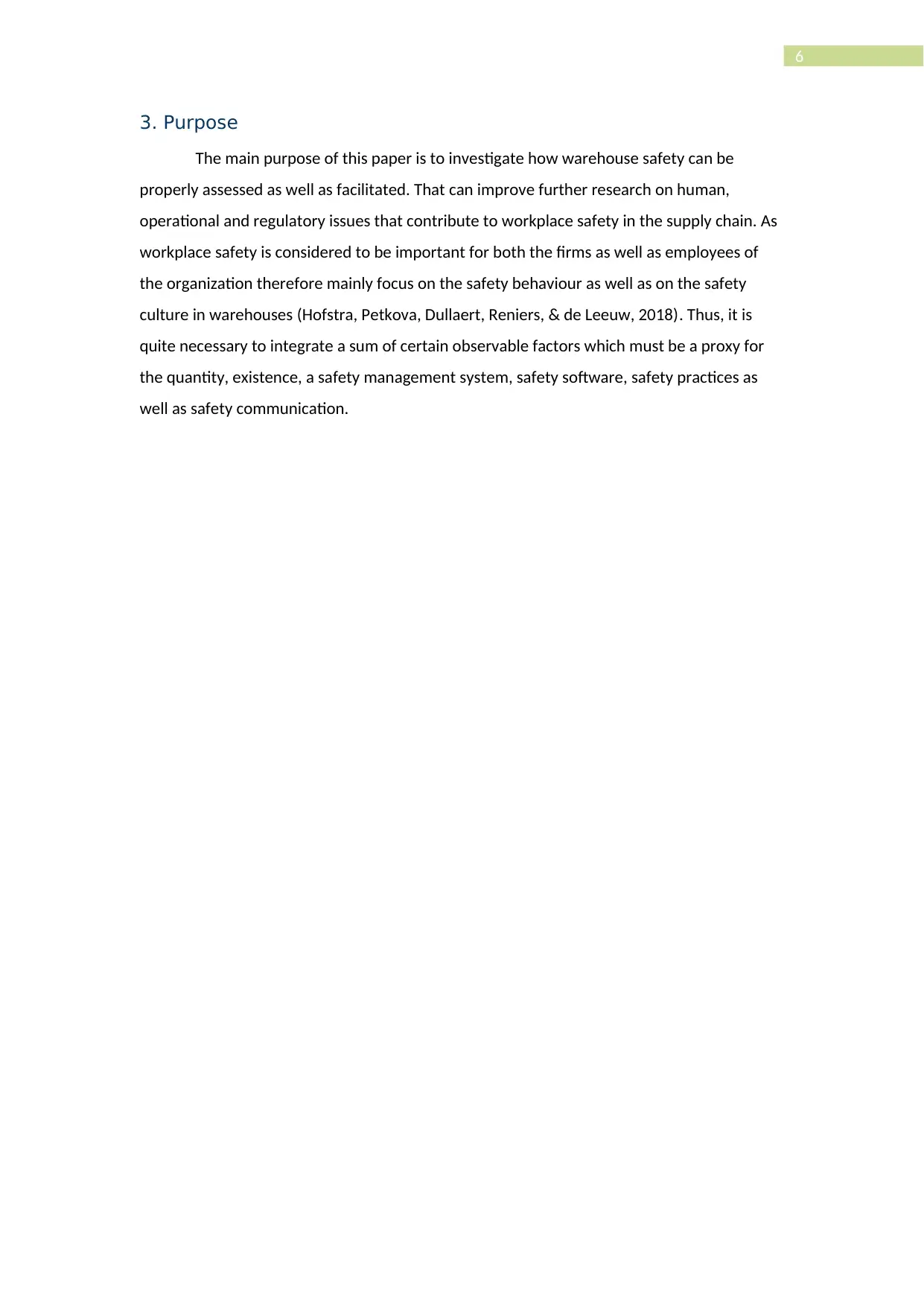
6
3. Purpose
The main purpose of this paper is to investigate how warehouse safety can be
properly assessed as well as facilitated. That can improve further research on human,
operational and regulatory issues that contribute to workplace safety in the supply chain. As
workplace safety is considered to be important for both the firms as well as employees of
the organization therefore mainly focus on the safety behaviour as well as on the safety
culture in warehouses (Hofstra, Petkova, Dullaert, Reniers, & de Leeuw, 2018). Thus, it is
quite necessary to integrate a sum of certain observable factors which must be a proxy for
the quantity, existence, a safety management system, safety software, safety practices as
well as safety communication.
3. Purpose
The main purpose of this paper is to investigate how warehouse safety can be
properly assessed as well as facilitated. That can improve further research on human,
operational and regulatory issues that contribute to workplace safety in the supply chain. As
workplace safety is considered to be important for both the firms as well as employees of
the organization therefore mainly focus on the safety behaviour as well as on the safety
culture in warehouses (Hofstra, Petkova, Dullaert, Reniers, & de Leeuw, 2018). Thus, it is
quite necessary to integrate a sum of certain observable factors which must be a proxy for
the quantity, existence, a safety management system, safety software, safety practices as
well as safety communication.
Paraphrase This Document
Need a fresh take? Get an instant paraphrase of this document with our AI Paraphraser
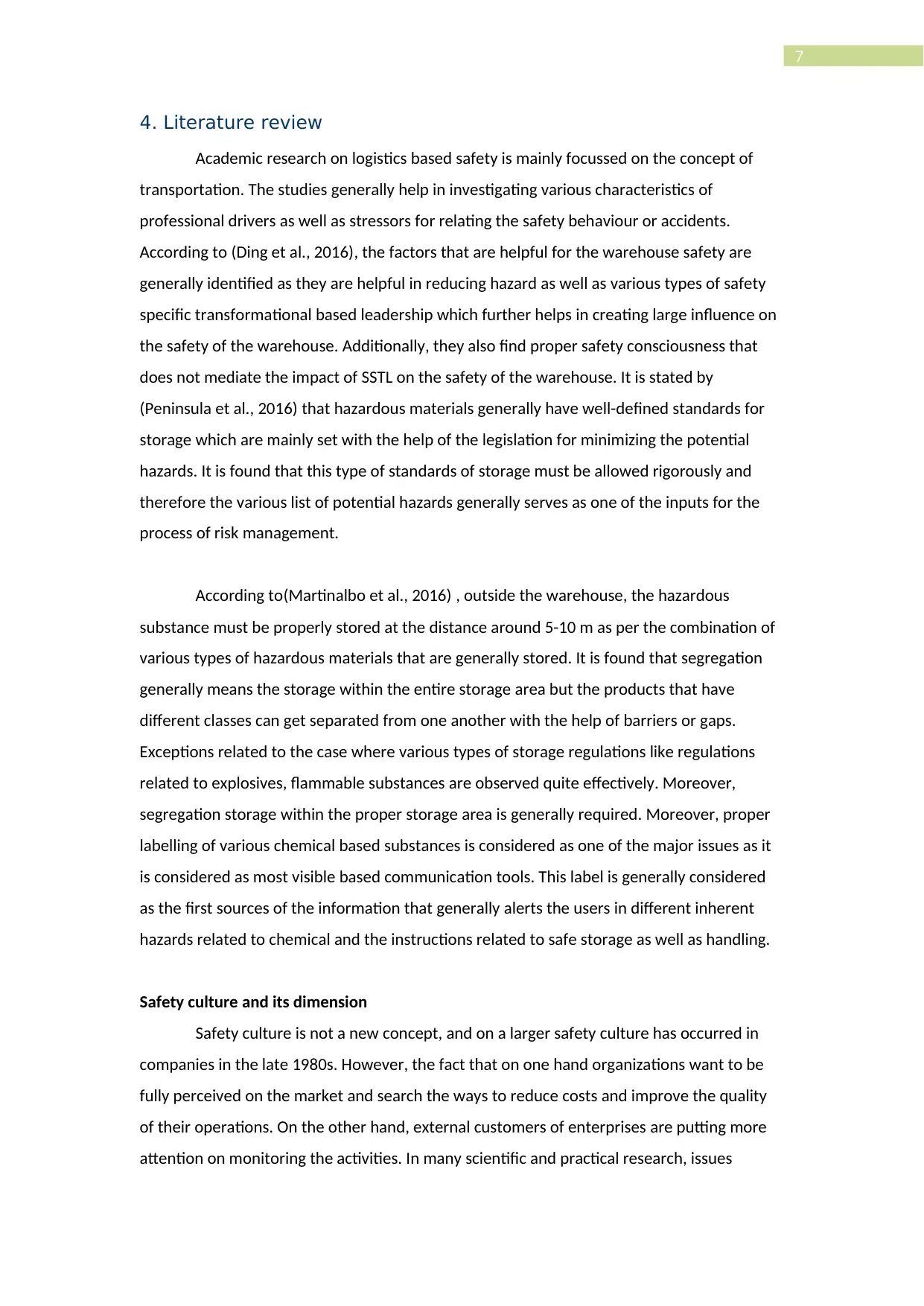
7
4. Literature review
Academic research on logistics based safety is mainly focussed on the concept of
transportation. The studies generally help in investigating various characteristics of
professional drivers as well as stressors for relating the safety behaviour or accidents.
According to (Ding et al., 2016), the factors that are helpful for the warehouse safety are
generally identified as they are helpful in reducing hazard as well as various types of safety
specific transformational based leadership which further helps in creating large influence on
the safety of the warehouse. Additionally, they also find proper safety consciousness that
does not mediate the impact of SSTL on the safety of the warehouse. It is stated by
(Peninsula et al., 2016) that hazardous materials generally have well-defined standards for
storage which are mainly set with the help of the legislation for minimizing the potential
hazards. It is found that this type of standards of storage must be allowed rigorously and
therefore the various list of potential hazards generally serves as one of the inputs for the
process of risk management.
According to(Martinalbo et al., 2016) , outside the warehouse, the hazardous
substance must be properly stored at the distance around 5-10 m as per the combination of
various types of hazardous materials that are generally stored. It is found that segregation
generally means the storage within the entire storage area but the products that have
different classes can get separated from one another with the help of barriers or gaps.
Exceptions related to the case where various types of storage regulations like regulations
related to explosives, flammable substances are observed quite effectively. Moreover,
segregation storage within the proper storage area is generally required. Moreover, proper
labelling of various chemical based substances is considered as one of the major issues as it
is considered as most visible based communication tools. This label is generally considered
as the first sources of the information that generally alerts the users in different inherent
hazards related to chemical and the instructions related to safe storage as well as handling.
Safety culture and its dimension
Safety culture is not a new concept, and on a larger safety culture has occurred in
companies in the late 1980s. However, the fact that on one hand organizations want to be
fully perceived on the market and search the ways to reduce costs and improve the quality
of their operations. On the other hand, external customers of enterprises are putting more
attention on monitoring the activities. In many scientific and practical research, issues
4. Literature review
Academic research on logistics based safety is mainly focussed on the concept of
transportation. The studies generally help in investigating various characteristics of
professional drivers as well as stressors for relating the safety behaviour or accidents.
According to (Ding et al., 2016), the factors that are helpful for the warehouse safety are
generally identified as they are helpful in reducing hazard as well as various types of safety
specific transformational based leadership which further helps in creating large influence on
the safety of the warehouse. Additionally, they also find proper safety consciousness that
does not mediate the impact of SSTL on the safety of the warehouse. It is stated by
(Peninsula et al., 2016) that hazardous materials generally have well-defined standards for
storage which are mainly set with the help of the legislation for minimizing the potential
hazards. It is found that this type of standards of storage must be allowed rigorously and
therefore the various list of potential hazards generally serves as one of the inputs for the
process of risk management.
According to(Martinalbo et al., 2016) , outside the warehouse, the hazardous
substance must be properly stored at the distance around 5-10 m as per the combination of
various types of hazardous materials that are generally stored. It is found that segregation
generally means the storage within the entire storage area but the products that have
different classes can get separated from one another with the help of barriers or gaps.
Exceptions related to the case where various types of storage regulations like regulations
related to explosives, flammable substances are observed quite effectively. Moreover,
segregation storage within the proper storage area is generally required. Moreover, proper
labelling of various chemical based substances is considered as one of the major issues as it
is considered as most visible based communication tools. This label is generally considered
as the first sources of the information that generally alerts the users in different inherent
hazards related to chemical and the instructions related to safe storage as well as handling.
Safety culture and its dimension
Safety culture is not a new concept, and on a larger safety culture has occurred in
companies in the late 1980s. However, the fact that on one hand organizations want to be
fully perceived on the market and search the ways to reduce costs and improve the quality
of their operations. On the other hand, external customers of enterprises are putting more
attention on monitoring the activities. In many scientific and practical research, issues
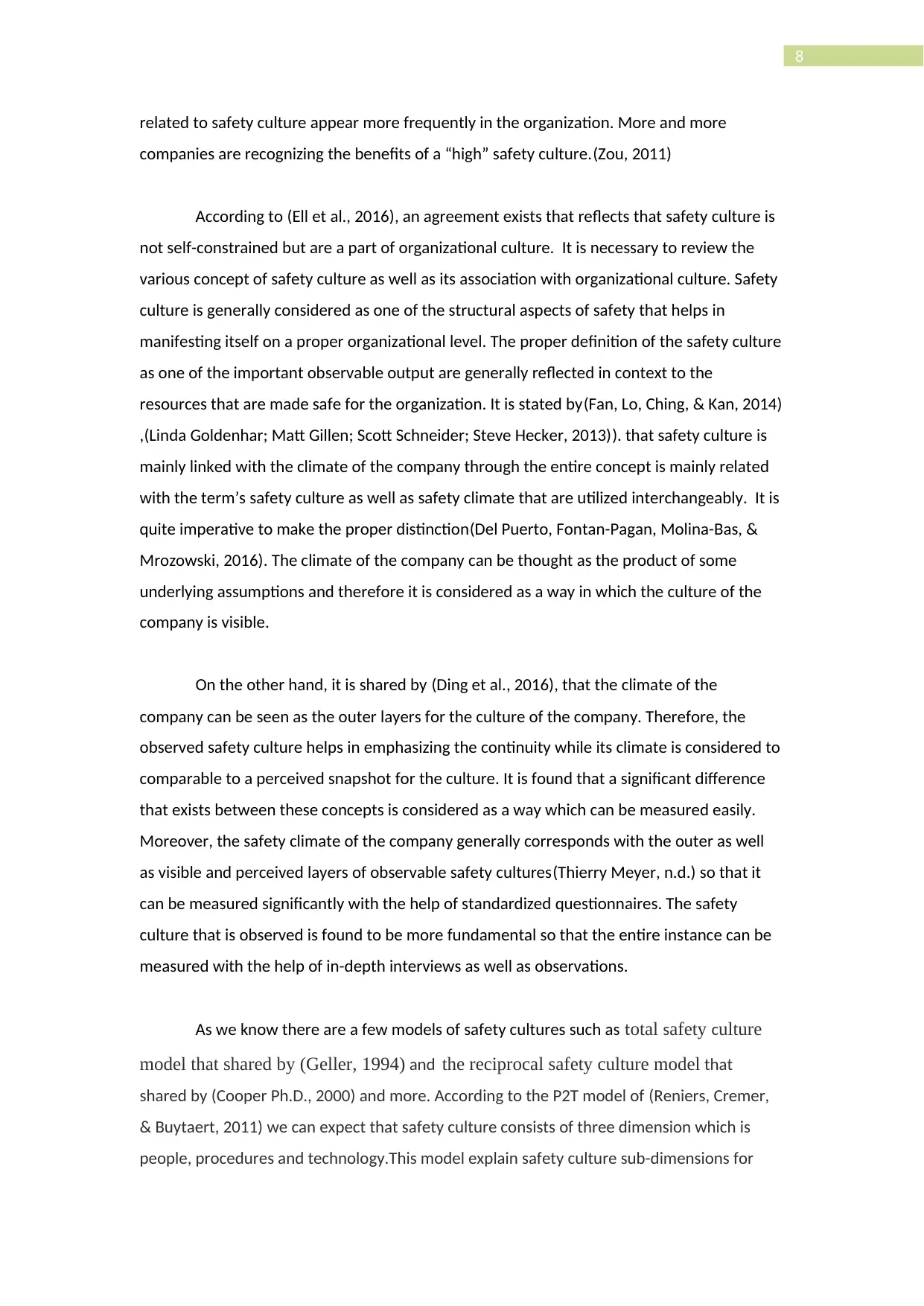
8
related to safety culture appear more frequently in the organization. More and more
companies are recognizing the benefits of a “high” safety culture.(Zou, 2011)
According to (Ell et al., 2016), an agreement exists that reflects that safety culture is
not self-constrained but are a part of organizational culture. It is necessary to review the
various concept of safety culture as well as its association with organizational culture. Safety
culture is generally considered as one of the structural aspects of safety that helps in
manifesting itself on a proper organizational level. The proper definition of the safety culture
as one of the important observable output are generally reflected in context to the
resources that are made safe for the organization. It is stated by(Fan, Lo, Ching, & Kan, 2014)
,(Linda Goldenhar; Matt Gillen; Scott Schneider; Steve Hecker, 2013)). that safety culture is
mainly linked with the climate of the company through the entire concept is mainly related
with the term’s safety culture as well as safety climate that are utilized interchangeably. It is
quite imperative to make the proper distinction(Del Puerto, Fontan-Pagan, Molina-Bas, &
Mrozowski, 2016). The climate of the company can be thought as the product of some
underlying assumptions and therefore it is considered as a way in which the culture of the
company is visible.
On the other hand, it is shared by (Ding et al., 2016), that the climate of the
company can be seen as the outer layers for the culture of the company. Therefore, the
observed safety culture helps in emphasizing the continuity while its climate is considered to
comparable to a perceived snapshot for the culture. It is found that a significant difference
that exists between these concepts is considered as a way which can be measured easily.
Moreover, the safety climate of the company generally corresponds with the outer as well
as visible and perceived layers of observable safety cultures(Thierry Meyer, n.d.) so that it
can be measured significantly with the help of standardized questionnaires. The safety
culture that is observed is found to be more fundamental so that the entire instance can be
measured with the help of in-depth interviews as well as observations.
As we know there are a few models of safety cultures such as total safety culture
model that shared by (Geller, 1994) and the reciprocal safety culture model that
shared by (Cooper Ph.D., 2000) and more. According to the P2T model of (Reniers, Cremer,
& Buytaert, 2011) we can expect that safety culture consists of three dimension which is
people, procedures and technology.This model explain safety culture sub-dimensions for
related to safety culture appear more frequently in the organization. More and more
companies are recognizing the benefits of a “high” safety culture.(Zou, 2011)
According to (Ell et al., 2016), an agreement exists that reflects that safety culture is
not self-constrained but are a part of organizational culture. It is necessary to review the
various concept of safety culture as well as its association with organizational culture. Safety
culture is generally considered as one of the structural aspects of safety that helps in
manifesting itself on a proper organizational level. The proper definition of the safety culture
as one of the important observable output are generally reflected in context to the
resources that are made safe for the organization. It is stated by(Fan, Lo, Ching, & Kan, 2014)
,(Linda Goldenhar; Matt Gillen; Scott Schneider; Steve Hecker, 2013)). that safety culture is
mainly linked with the climate of the company through the entire concept is mainly related
with the term’s safety culture as well as safety climate that are utilized interchangeably. It is
quite imperative to make the proper distinction(Del Puerto, Fontan-Pagan, Molina-Bas, &
Mrozowski, 2016). The climate of the company can be thought as the product of some
underlying assumptions and therefore it is considered as a way in which the culture of the
company is visible.
On the other hand, it is shared by (Ding et al., 2016), that the climate of the
company can be seen as the outer layers for the culture of the company. Therefore, the
observed safety culture helps in emphasizing the continuity while its climate is considered to
comparable to a perceived snapshot for the culture. It is found that a significant difference
that exists between these concepts is considered as a way which can be measured easily.
Moreover, the safety climate of the company generally corresponds with the outer as well
as visible and perceived layers of observable safety cultures(Thierry Meyer, n.d.) so that it
can be measured significantly with the help of standardized questionnaires. The safety
culture that is observed is found to be more fundamental so that the entire instance can be
measured with the help of in-depth interviews as well as observations.
As we know there are a few models of safety cultures such as total safety culture
model that shared by (Geller, 1994) and the reciprocal safety culture model that
shared by (Cooper Ph.D., 2000) and more. According to the P2T model of (Reniers, Cremer,
& Buytaert, 2011) we can expect that safety culture consists of three dimension which is
people, procedures and technology.This model explain safety culture sub-dimensions for
⊘ This is a preview!⊘
Do you want full access?
Subscribe today to unlock all pages.

Trusted by 1+ million students worldwide
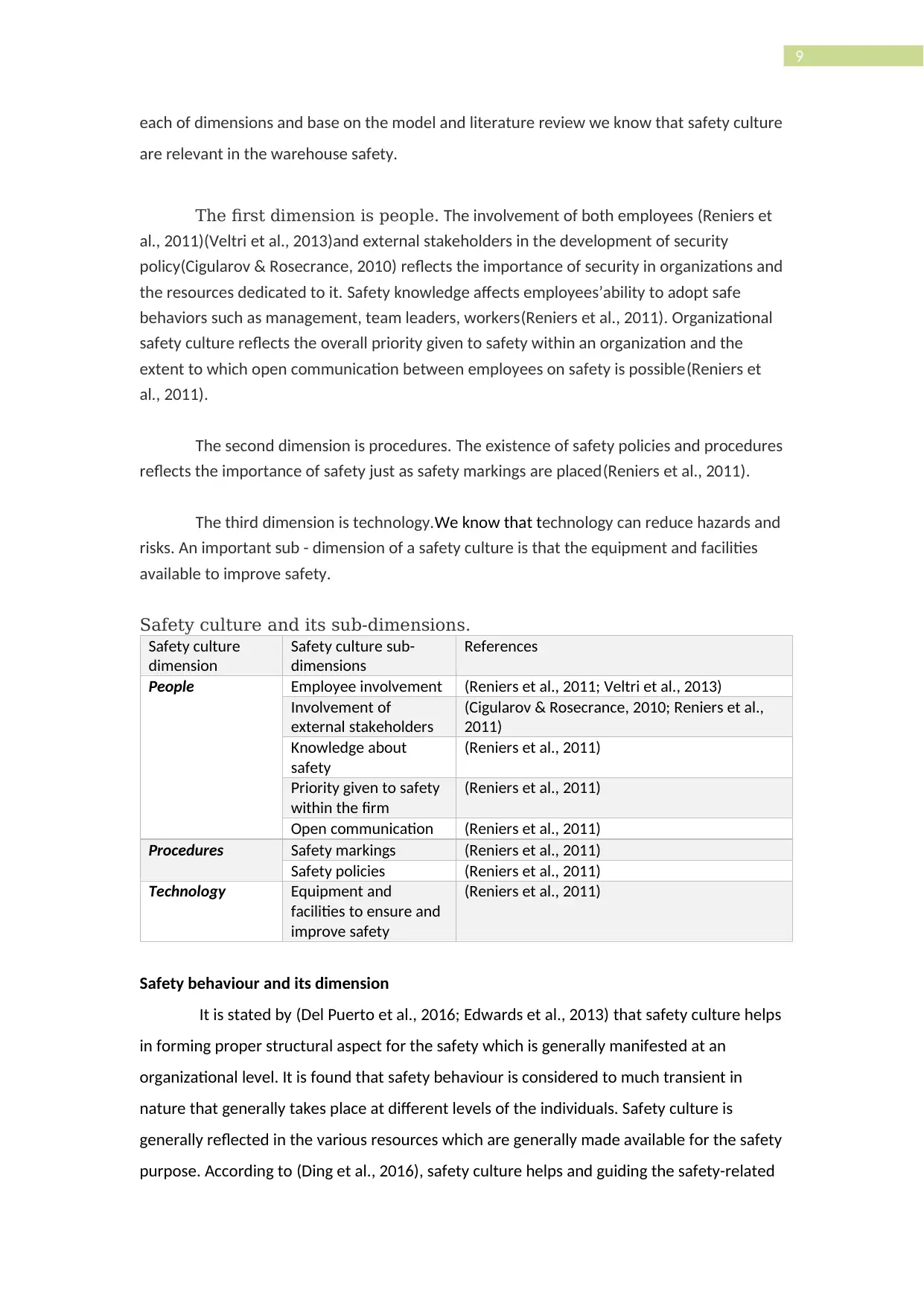
9
each of dimensions and base on the model and literature review we know that safety culture
are relevant in the warehouse safety.
The first dimension is people. The involvement of both employees (Reniers et
al., 2011)(Veltri et al., 2013)and external stakeholders in the development of security
policy(Cigularov & Rosecrance, 2010) reflects the importance of security in organizations and
the resources dedicated to it. Safety knowledge affects employees’ability to adopt safe
behaviors such as management, team leaders, workers(Reniers et al., 2011). Organizational
safety culture reflects the overall priority given to safety within an organization and the
extent to which open communication between employees on safety is possible(Reniers et
al., 2011).
The second dimension is procedures. The existence of safety policies and procedures
reflects the importance of safety just as safety markings are placed(Reniers et al., 2011).
The third dimension is technology.We know that technology can reduce hazards and
risks. An important sub - dimension of a safety culture is that the equipment and facilities
available to improve safety.
Safety culture and its sub-dimensions.
Safety culture
dimension
Safety culture sub-
dimensions
References
People Employee involvement (Reniers et al., 2011; Veltri et al., 2013)
Involvement of
external stakeholders
(Cigularov & Rosecrance, 2010; Reniers et al.,
2011)
Knowledge about
safety
(Reniers et al., 2011)
Priority given to safety
within the firm
(Reniers et al., 2011)
Open communication (Reniers et al., 2011)
Procedures Safety markings (Reniers et al., 2011)
Safety policies (Reniers et al., 2011)
Technology Equipment and
facilities to ensure and
improve safety
(Reniers et al., 2011)
Safety behaviour and its dimension
It is stated by (Del Puerto et al., 2016; Edwards et al., 2013) that safety culture helps
in forming proper structural aspect for the safety which is generally manifested at an
organizational level. It is found that safety behaviour is considered to much transient in
nature that generally takes place at different levels of the individuals. Safety culture is
generally reflected in the various resources which are generally made available for the safety
purpose. According to (Ding et al., 2016), safety culture helps and guiding the safety-related
each of dimensions and base on the model and literature review we know that safety culture
are relevant in the warehouse safety.
The first dimension is people. The involvement of both employees (Reniers et
al., 2011)(Veltri et al., 2013)and external stakeholders in the development of security
policy(Cigularov & Rosecrance, 2010) reflects the importance of security in organizations and
the resources dedicated to it. Safety knowledge affects employees’ability to adopt safe
behaviors such as management, team leaders, workers(Reniers et al., 2011). Organizational
safety culture reflects the overall priority given to safety within an organization and the
extent to which open communication between employees on safety is possible(Reniers et
al., 2011).
The second dimension is procedures. The existence of safety policies and procedures
reflects the importance of safety just as safety markings are placed(Reniers et al., 2011).
The third dimension is technology.We know that technology can reduce hazards and
risks. An important sub - dimension of a safety culture is that the equipment and facilities
available to improve safety.
Safety culture and its sub-dimensions.
Safety culture
dimension
Safety culture sub-
dimensions
References
People Employee involvement (Reniers et al., 2011; Veltri et al., 2013)
Involvement of
external stakeholders
(Cigularov & Rosecrance, 2010; Reniers et al.,
2011)
Knowledge about
safety
(Reniers et al., 2011)
Priority given to safety
within the firm
(Reniers et al., 2011)
Open communication (Reniers et al., 2011)
Procedures Safety markings (Reniers et al., 2011)
Safety policies (Reniers et al., 2011)
Technology Equipment and
facilities to ensure and
improve safety
(Reniers et al., 2011)
Safety behaviour and its dimension
It is stated by (Del Puerto et al., 2016; Edwards et al., 2013) that safety culture helps
in forming proper structural aspect for the safety which is generally manifested at an
organizational level. It is found that safety behaviour is considered to much transient in
nature that generally takes place at different levels of the individuals. Safety culture is
generally reflected in the various resources which are generally made available for the safety
purpose. According to (Ding et al., 2016), safety culture helps and guiding the safety-related
Paraphrase This Document
Need a fresh take? Get an instant paraphrase of this document with our AI Paraphraser
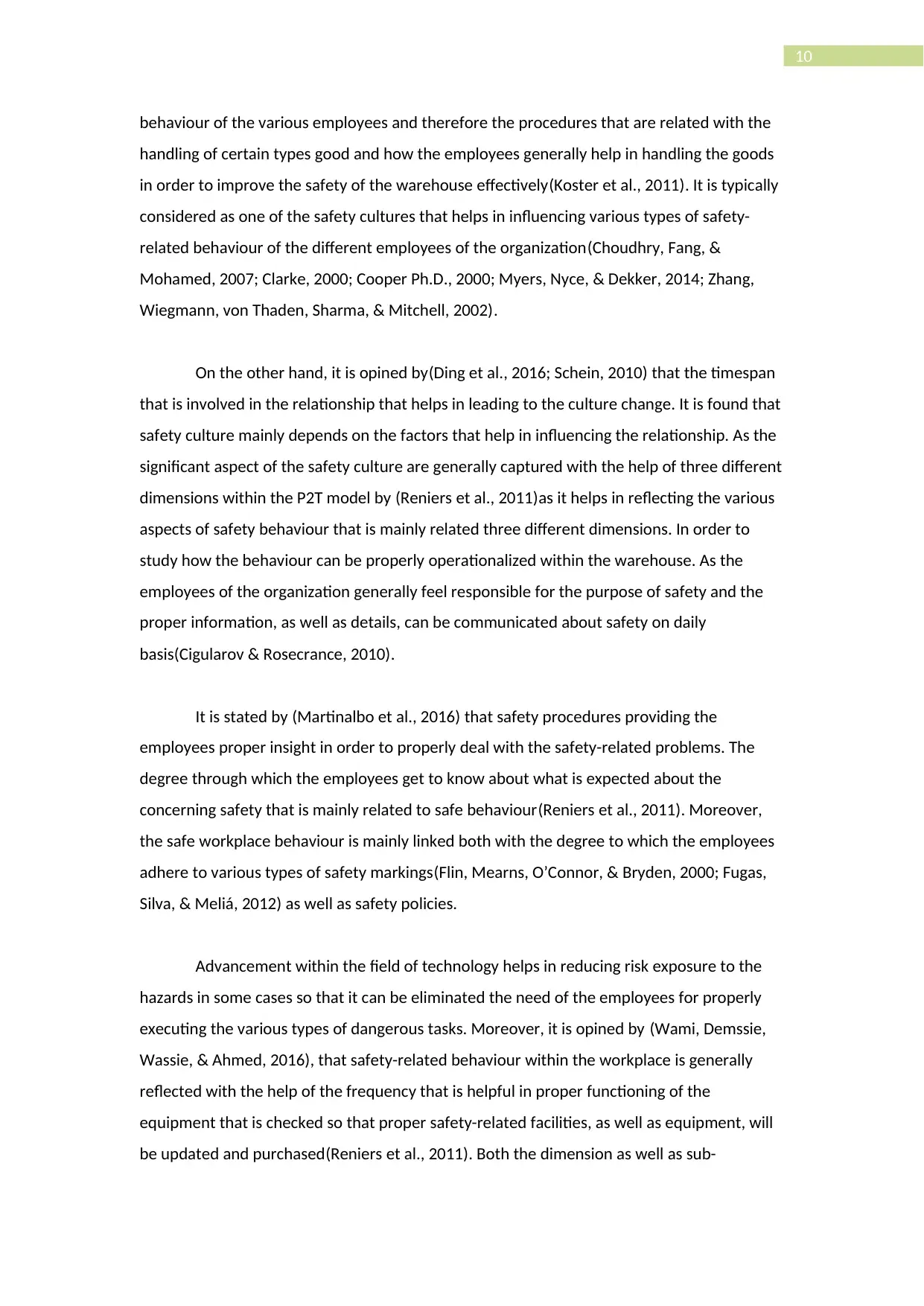
10
behaviour of the various employees and therefore the procedures that are related with the
handling of certain types good and how the employees generally help in handling the goods
in order to improve the safety of the warehouse effectively(Koster et al., 2011). It is typically
considered as one of the safety cultures that helps in influencing various types of safety-
related behaviour of the different employees of the organization(Choudhry, Fang, &
Mohamed, 2007; Clarke, 2000; Cooper Ph.D., 2000; Myers, Nyce, & Dekker, 2014; Zhang,
Wiegmann, von Thaden, Sharma, & Mitchell, 2002).
On the other hand, it is opined by(Ding et al., 2016; Schein, 2010) that the timespan
that is involved in the relationship that helps in leading to the culture change. It is found that
safety culture mainly depends on the factors that help in influencing the relationship. As the
significant aspect of the safety culture are generally captured with the help of three different
dimensions within the P2T model by (Reniers et al., 2011)as it helps in reflecting the various
aspects of safety behaviour that is mainly related three different dimensions. In order to
study how the behaviour can be properly operationalized within the warehouse. As the
employees of the organization generally feel responsible for the purpose of safety and the
proper information, as well as details, can be communicated about safety on daily
basis(Cigularov & Rosecrance, 2010).
It is stated by (Martinalbo et al., 2016) that safety procedures providing the
employees proper insight in order to properly deal with the safety-related problems. The
degree through which the employees get to know about what is expected about the
concerning safety that is mainly related to safe behaviour(Reniers et al., 2011). Moreover,
the safe workplace behaviour is mainly linked both with the degree to which the employees
adhere to various types of safety markings(Flin, Mearns, O’Connor, & Bryden, 2000; Fugas,
Silva, & Meliá, 2012) as well as safety policies.
Advancement within the field of technology helps in reducing risk exposure to the
hazards in some cases so that it can be eliminated the need of the employees for properly
executing the various types of dangerous tasks. Moreover, it is opined by (Wami, Demssie,
Wassie, & Ahmed, 2016), that safety-related behaviour within the workplace is generally
reflected with the help of the frequency that is helpful in proper functioning of the
equipment that is checked so that proper safety-related facilities, as well as equipment, will
be updated and purchased(Reniers et al., 2011). Both the dimension as well as sub-
behaviour of the various employees and therefore the procedures that are related with the
handling of certain types good and how the employees generally help in handling the goods
in order to improve the safety of the warehouse effectively(Koster et al., 2011). It is typically
considered as one of the safety cultures that helps in influencing various types of safety-
related behaviour of the different employees of the organization(Choudhry, Fang, &
Mohamed, 2007; Clarke, 2000; Cooper Ph.D., 2000; Myers, Nyce, & Dekker, 2014; Zhang,
Wiegmann, von Thaden, Sharma, & Mitchell, 2002).
On the other hand, it is opined by(Ding et al., 2016; Schein, 2010) that the timespan
that is involved in the relationship that helps in leading to the culture change. It is found that
safety culture mainly depends on the factors that help in influencing the relationship. As the
significant aspect of the safety culture are generally captured with the help of three different
dimensions within the P2T model by (Reniers et al., 2011)as it helps in reflecting the various
aspects of safety behaviour that is mainly related three different dimensions. In order to
study how the behaviour can be properly operationalized within the warehouse. As the
employees of the organization generally feel responsible for the purpose of safety and the
proper information, as well as details, can be communicated about safety on daily
basis(Cigularov & Rosecrance, 2010).
It is stated by (Martinalbo et al., 2016) that safety procedures providing the
employees proper insight in order to properly deal with the safety-related problems. The
degree through which the employees get to know about what is expected about the
concerning safety that is mainly related to safe behaviour(Reniers et al., 2011). Moreover,
the safe workplace behaviour is mainly linked both with the degree to which the employees
adhere to various types of safety markings(Flin, Mearns, O’Connor, & Bryden, 2000; Fugas,
Silva, & Meliá, 2012) as well as safety policies.
Advancement within the field of technology helps in reducing risk exposure to the
hazards in some cases so that it can be eliminated the need of the employees for properly
executing the various types of dangerous tasks. Moreover, it is opined by (Wami, Demssie,
Wassie, & Ahmed, 2016), that safety-related behaviour within the workplace is generally
reflected with the help of the frequency that is helpful in proper functioning of the
equipment that is checked so that proper safety-related facilities, as well as equipment, will
be updated and purchased(Reniers et al., 2011). Both the dimension as well as sub-
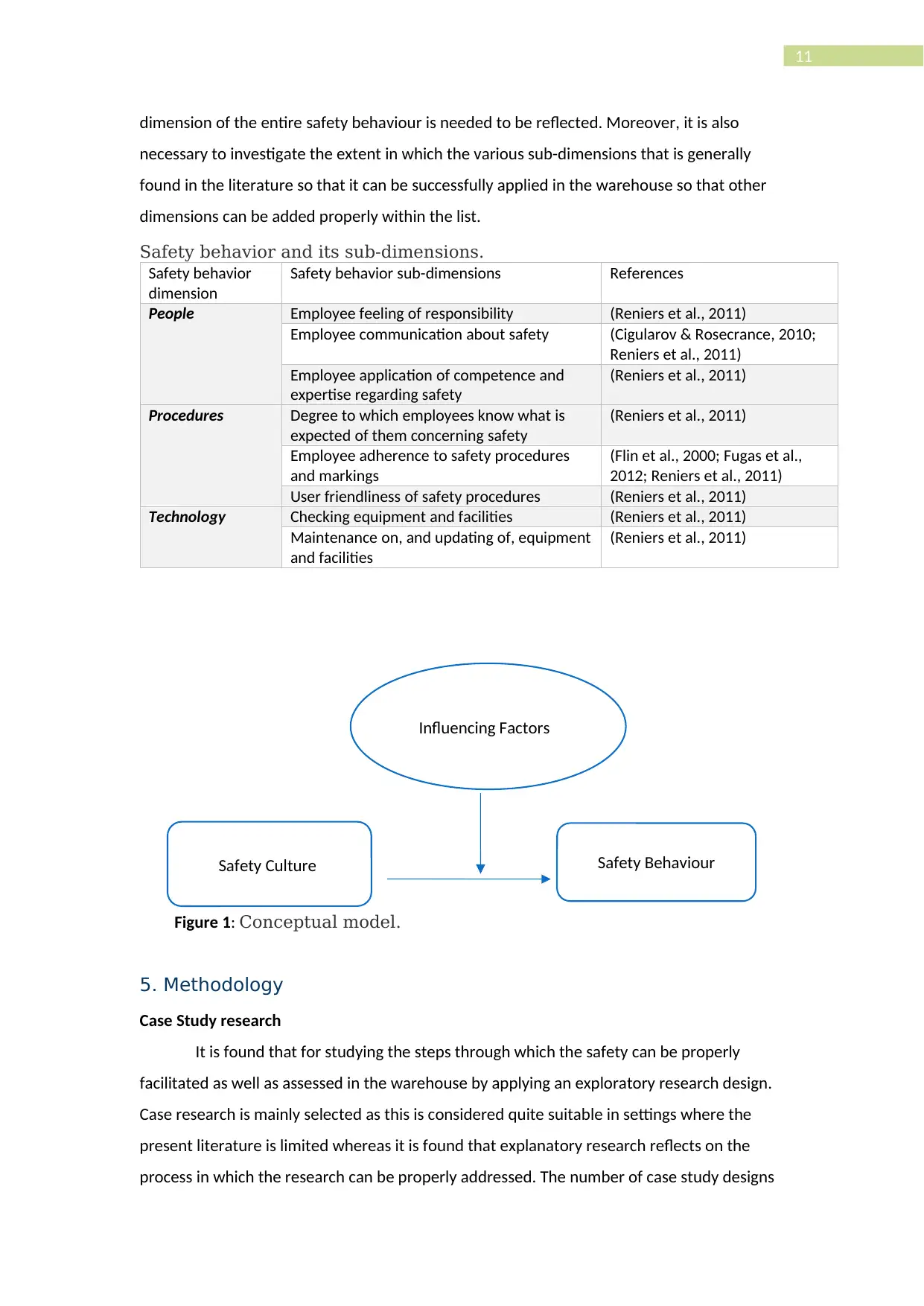
11
dimension of the entire safety behaviour is needed to be reflected. Moreover, it is also
necessary to investigate the extent in which the various sub-dimensions that is generally
found in the literature so that it can be successfully applied in the warehouse so that other
dimensions can be added properly within the list.
Safety behavior and its sub-dimensions.
Safety behavior
dimension
Safety behavior sub-dimensions References
People Employee feeling of responsibility (Reniers et al., 2011)
Employee communication about safety (Cigularov & Rosecrance, 2010;
Reniers et al., 2011)
Employee application of competence and
expertise regarding safety
(Reniers et al., 2011)
Procedures Degree to which employees know what is
expected of them concerning safety
(Reniers et al., 2011)
Employee adherence to safety procedures
and markings
(Flin et al., 2000; Fugas et al.,
2012; Reniers et al., 2011)
User friendliness of safety procedures (Reniers et al., 2011)
Technology Checking equipment and facilities (Reniers et al., 2011)
Maintenance on, and updating of, equipment
and facilities
(Reniers et al., 2011)
Figure 1: Conceptual model.
5. Methodology
Case Study research
It is found that for studying the steps through which the safety can be properly
facilitated as well as assessed in the warehouse by applying an exploratory research design.
Case research is mainly selected as this is considered quite suitable in settings where the
present literature is limited whereas it is found that explanatory research reflects on the
process in which the research can be properly addressed. The number of case study designs
Influencing Factors
Safety Culture Safety Behaviour
dimension of the entire safety behaviour is needed to be reflected. Moreover, it is also
necessary to investigate the extent in which the various sub-dimensions that is generally
found in the literature so that it can be successfully applied in the warehouse so that other
dimensions can be added properly within the list.
Safety behavior and its sub-dimensions.
Safety behavior
dimension
Safety behavior sub-dimensions References
People Employee feeling of responsibility (Reniers et al., 2011)
Employee communication about safety (Cigularov & Rosecrance, 2010;
Reniers et al., 2011)
Employee application of competence and
expertise regarding safety
(Reniers et al., 2011)
Procedures Degree to which employees know what is
expected of them concerning safety
(Reniers et al., 2011)
Employee adherence to safety procedures
and markings
(Flin et al., 2000; Fugas et al.,
2012; Reniers et al., 2011)
User friendliness of safety procedures (Reniers et al., 2011)
Technology Checking equipment and facilities (Reniers et al., 2011)
Maintenance on, and updating of, equipment
and facilities
(Reniers et al., 2011)
Figure 1: Conceptual model.
5. Methodology
Case Study research
It is found that for studying the steps through which the safety can be properly
facilitated as well as assessed in the warehouse by applying an exploratory research design.
Case research is mainly selected as this is considered quite suitable in settings where the
present literature is limited whereas it is found that explanatory research reflects on the
process in which the research can be properly addressed. The number of case study designs
Influencing Factors
Safety Culture Safety Behaviour
⊘ This is a preview!⊘
Do you want full access?
Subscribe today to unlock all pages.

Trusted by 1+ million students worldwide
1 out of 26
Related Documents
Your All-in-One AI-Powered Toolkit for Academic Success.
+13062052269
info@desklib.com
Available 24*7 on WhatsApp / Email
![[object Object]](/_next/static/media/star-bottom.7253800d.svg)
Unlock your academic potential
Copyright © 2020–2025 A2Z Services. All Rights Reserved. Developed and managed by ZUCOL.





